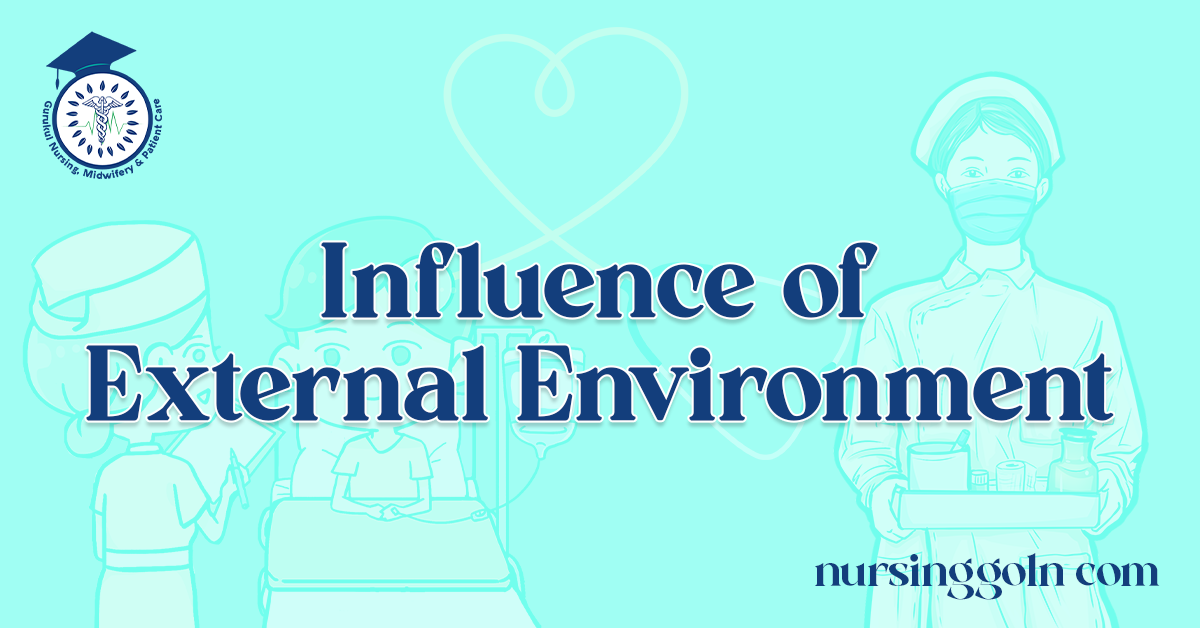Today our topic of discussion is Influence of External Environment .
Influence of External Environment

Atmospheric temperature: In an ideal temperature, the person does not feel chilly, but it should be sufficiently warm enough to cause perspiration. A room temperature ranging from 68 to 72° F (20-22°C) is considered comfortable.
Humidity: Humidity is the amount of moisture in the air. It affects the evaporation of moisture from the skin. A humidity of 40-60% considered comfortable.
Air Movement
Ventilation means movement in the air. The chief purpose of ventilation is to supply fresh air and to maintain a proper humidity. Air in motion increases the radiation of heat from the skin and improves circulation and respiration. The velocity of the air movement should be 15-45 feet/minute or 1-3 miles/hour.
Air may keep in motion by opening doors and windows, and by the use of fans and air conditioners. The air movement should not be much to cause draughts.
Lighting
The amount of light is an important factor in comfort. It is provided by natural or artificial light. Avoid direct light on the face and eyes. Prevent glare. Artificial light should not be too strong for reading. Remember it is difficult for a patient to rest when there is excessive light.
He will not be able to read and write when there is dim light. The amount of light depends upon the use of light, the kind of work being done, conditions of the patient, age of the patient and the time of the day. The patient if conscious should have within his reach a light, which he can control.
Noise
Noise produces irritability, restlessness, fatigue and exhaustion. In an acutely ill patient noise interfere with sleep. On the contrary, a melodious sound induces pleasure. The degree of noise may be reduced by various measures. Noise caused by friction may be reduced by lubrication.
Use of rubber tyres and castors for trolleys and wheel chairs reduce the sound when moving furniture. Make echo proof rooms. Avoid dropping object. Loud talking, laughing and heavy walking with shoes should be avoided. Whispering is also not good, as it tends to cause apprehension and uncertainty in the patient.
Purity of Air
Dust cause significant hazards to patients. Dust in hospital may be laden with microorganisms, which cause infection in addition to irritation of the respiratory tract of precipitating allergic reaction.
To control the dust, it is important to avoid those activities that stirrup dust such as dusting and dry duster and sweeping damp dusting and cleaning, folding bed linen and gently shaking them rather than flapping them, restricting the cigarette smoking and above all providing proper ventilation and ample spacing of bed maintains the purity of air.

Elimination of Unpleasant Odors
Good ventilation, cleanliness, proper disposal of excreta and rubbish are necessary to eliminate unpleasant odors.
Water Supply and Sewage Disposal
There should be provision for safe water supply and disposal of excreta.
Esthetic Factor
The environment becomes attractive it appeals to the series whether we are conscious or not, the design or arrangement of the room contributes to its harmony. Through skillful use of color, the room can be made attractive. Color preferences vary with age, sex and race. Flower vase, picture and curtains add to the pleasant outlook of the room.
Esthetic considerations should include freedom from unpleasant sights. Bedpans, urinals, soiled dressings and used linen, etc, should be removed from the sick room immediately.
Optimum Environment for the Patient
Influence of external environment are atmospheric temperature, humidity, air movement, lighting, noise, purity of air, elimination of unpleasant odors, water supply and sewage disposal and esthetic factors.
Factors of safety include freedom from mechanical injury, thermal injury, chemical injury, radiation, bacteriologic ingests, allergens, free from vermin, insects and animal pests.
Furnishing for the patients unit are cot, spread over bed, table, bedside locker, bedside table, chair and stool, bedside commode, bed pans and urinals, sputum cup, kidney trays, water flasks and drinking glasses, plate, spoon, fork, knives and toilet articles.
Carliolization
Carliolization is a process of disinfecting the whole external environment of the patient and rendering it free from 1 pathogenic organisms.

Vermin and Insects
- Clean the patients unit regularly. Eliminate all the breeding places. Keep garbage well-covered and dispose of all refuse properly Store food properly.
- Use fly screens on windows and doors.
Read more:
